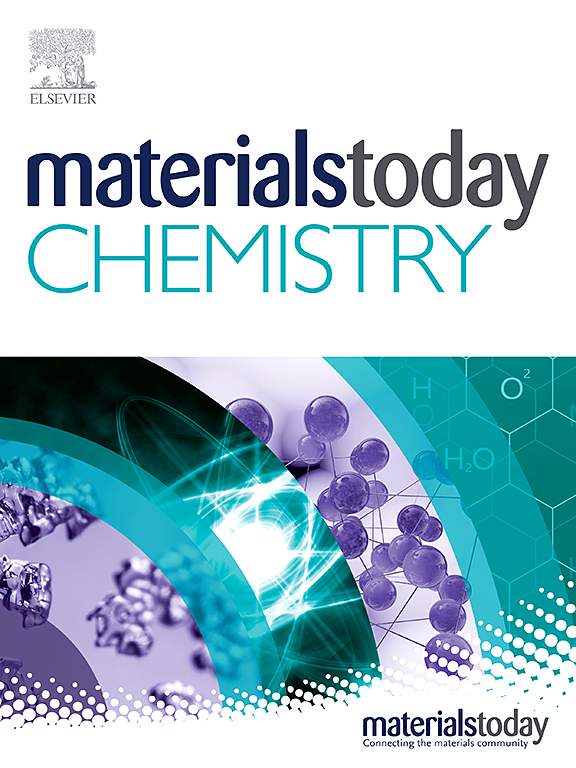甲烷干重整中的钼酸盐基双包晶材料
IF 6.7
2区 化学
Q1 CHEMISTRY, MULTIDISCIPLINARY
引用次数: 0
摘要
我们测试了一系列具有代表性的 SrMMoO(M = Ni、Co 和 (Ni,Co))化合物,以突出双包晶结构作为甲烷干重整(DRM)应用前驱体材料的能力。在纯氢或干重整 CO/CH 混合物中进行预处理时,最初的双包晶石结构会发生部分分解,小的 Ni 或 CoO 颗粒会溶出,并形成其他结晶化合物,如 SrMoO 或 SrCO(在 DRM 混合物中)。在纯氢气氛中进行的原位 X 射线衍射测量揭示了有缺陷的 SrMoO 瞬态相的形成。含镍和含钴的钼酸锶包晶结构之间的主要区别在于外溶解钴的氧化倾向更强,这很可能是由于部分完整的双包晶结构提供了氧气。对于 SrNiMoO 而言,如果在 DRM 实验前在氢气中进行预还原步骤,或者在 DRM 混合物中直接分解 SrNiMoO,则所产生的金属 Ni- 双包晶界面具有很高的 DRM 活性,不会产生强烈的结焦现象。尽管发生了部分分解,但相应的 SrCoMoO 结构在 DRM 操作中并不活跃,这很可能是由于原位形成了小的外溶 CoO 颗粒,而 Ni 则以金属态外溶。人们采用了不同的策略来提高催化活性,包括混合氢、增强 A 位缺陷或与镍共合金化,但只有后者对提高 SrNiCoMoO 成分的 DRM 活性有好处。在硒镍钴钼氧化物中,镍取代钴抑制了钴的氧化倾向,在 DRM 过程中产生了富钴的镍钴合金纳米颗粒的溶解。我们还发现,作为 B'位阳离子的钼对还原和 DRM 处理有强烈的反应,导致在溶出过程中形成还原的 MoO 相。本文章由计算机程序翻译,如有差异,请以英文原文为准。
Molybdate-based double perovskite materials in methane dry reforming
A series of SrMMoO (M = Ni, Co and (Ni,Co)) compounds was tested as representative model systems to highlight the capabilities of double perovskite structures as precursor materials for methane dry reforming (DRM) applications. Pretreatments in either pure hydrogen or dry reforming CO/CH mixtures exclusively yield partial decomposition of the initial double perovskite structures through exsolution of small Ni or CoO particles and the associated formation of additional crystalline compounds, such as SrMoO or SrCO (in DRM mixtures). The formation of a defective SrMoO transient phase has been revealed by in situ X-ray diffraction measurements in a pure hydrogen atmosphere. The main difference between the Ni- and Co-containing Sr molybdate perovskite structures is the much stronger oxidation propensity of exsolved Co, most likely by oxygen supply from the partially intact double perovskite structure. For SrNiMoO, the resulting metallic Ni-double perovskite interface is highly DRM active without strong coking, both if a pre-reduction step in hydrogen is carried out before the DRM experiment or if SrNiMoO is directly decomposed in the DRM mixture. Despite partial decomposition, the corresponding SrCoMoO structure is not active under DRM operation, most likely due to the in situ formation of small exsolved CoO particles, while Ni is exsolved in its metallic state. Different strategies to improve the catalytic activity, including hydrogen by-mixing, enhanced A-site deficiency or co-alloying with Ni have been followed, but only the latter has a beneficial effect on improving the DRM activity at compositions of SrNiCoMoO. In SrNiCoMoO, the substitution of Co by Ni suppresses the oxidation propensity of Co and during DRM yields the exsolution of Co-rich Ni–Co alloy nanoparticles. We also reveal a strong response of molybdenum as the B’ site cation to reduction and DRM treatment, causing the formation of reduced MoO phases accompanying the exsolution process.
求助全文
通过发布文献求助,成功后即可免费获取论文全文。
去求助
来源期刊

Materials Today Chemistry
Multiple-
CiteScore
8.90
自引率
6.80%
发文量
596
审稿时长
33 days
期刊介绍:
Materials Today Chemistry is a multi-disciplinary journal dedicated to all facets of materials chemistry.
This field represents one of the fastest-growing areas of science, involving the application of chemistry-based techniques to the study of materials. It encompasses materials synthesis and behavior, as well as the intricate relationships between material structure and properties at the atomic and molecular scale. Materials Today Chemistry serves as a high-impact platform for discussing research that propels the field forward through groundbreaking discoveries and innovative techniques.
 求助内容:
求助内容: 应助结果提醒方式:
应助结果提醒方式:


